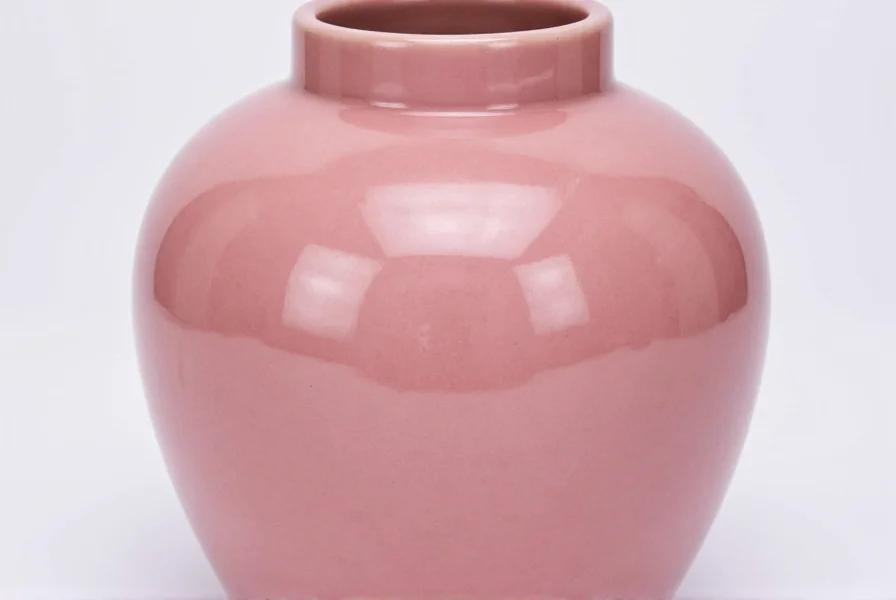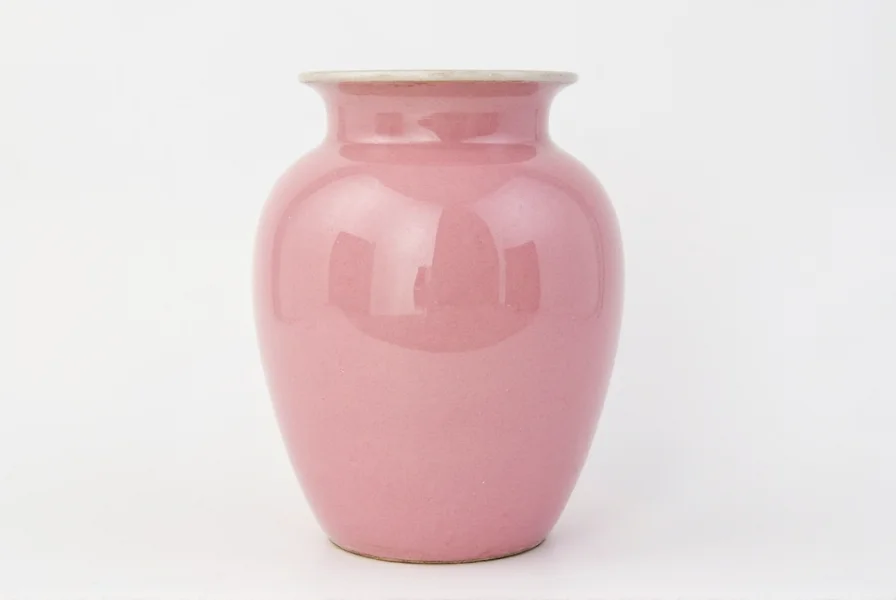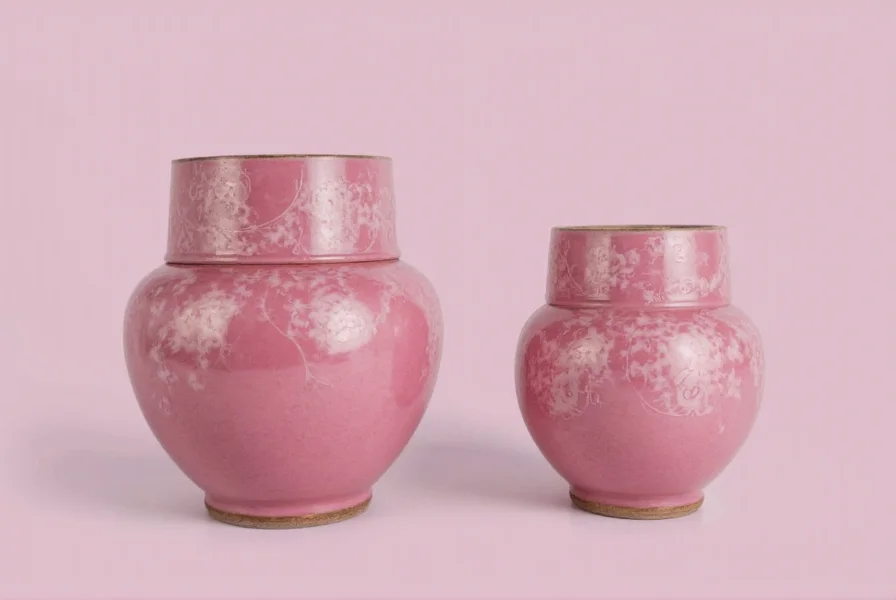Pink ginger jars represent a fascinating intersection of Chinese ceramic tradition and Western decorative tastes. While all ginger jars share common structural elements—a rounded body, narrow neck, and domed lid—the pink variation stands out for its delicate coloration that became particularly popular during the 18th and 19th centuries. Unlike their blue-and-white counterparts which are more commonly recognized, pink ginger jars showcase a sophisticated palette achieved through careful kiln firing techniques that transformed certain mineral compounds in the glaze.
Historical Evolution of Pink Ginger Jars
The story of pink ginger jars begins in China's Jiangxi province, home to the imperial kilns of Jingdezhen. Originally created during the Ming Dynasty (1368-1644) for practical storage of spices, herbs, and medicines, these vessels gained prominence during the Qing Dynasty (1644-1912) when European demand transformed them into luxury decorative objects. The distinctive pink color emerged as potters experimented with iron oxide and colloidal gold in their glazes, creating what collectors now call famille rose ("rose family") porcelain.
Western merchants trading through the Canton System eagerly purchased these pieces, often commissioning custom designs that blended Chinese motifs with European tastes. By the late 18th century, pink ginger jars had become status symbols in European and American homes, displayed prominently in parlors and dining rooms as evidence of worldly sophistication.
What Creates the Distinctive Pink Hue
The pink coloration in authentic antique ginger jars results from precise ceramic chemistry rather than simple decoration. Craftsmen achieved this effect through several methods:
| Coloration Method | Time Period | Characteristics |
|---|---|---|
| Iron Oxide Reduction | Qing Dynasty (1700s) | Subtle rose tones from controlled oxygen levels during firing |
| Famille Rose Enamels | Mid-18th century onward | Brighter pink hues using opaque enamel paints over glaze |
| Gold Luster | 19th century | Rare coral tones created with colloidal gold in glaze |
Collectors distinguish between these techniques when evaluating authenticity. True antique pink ginger jars show subtle color variations and slight imperfections that mass-produced reproductions lack. The most valuable pieces feature hand-painted floral motifs, dragons, or landscape scenes in complementary colors that enhance rather than overwhelm the pink base.

Identifying Authentic Pink Ginger Jars
Distinguishing genuine antique pink ginger jars from modern reproductions requires attention to specific details. Experienced collectors examine these key elements:
- Base markings: Authentic pieces often bear reign marks of Chinese emperors or workshop identifiers, though many export pieces lack these
- Glaze quality: Antique glazes show slight variations and "orange peel" texture, while modern pieces have perfectly uniform surfaces
- Color depth: Genuine pink hues penetrate the glaze rather than sitting on top
- Construction: Hand-thrown pieces show subtle asymmetry; machine-made reproductions are perfectly symmetrical
- Wear patterns: Authentic antiques display consistent wear on high-contact areas like the rim and base
When evaluating pink ginger jar value, collectors consider the intensity and evenness of the pink coloration alongside decorative quality. Pieces with vibrant but not garish pink tones featuring intricate hand-painted details command premium prices, especially those dating from the Qianlong period (1736-1795) when famille rose porcelain reached its artistic peak.
Contemporary Uses and Collecting Trends
While antique pink ginger jars remain prized collectibles, modern interpretations have gained popularity in interior design. Today's decorators use both authentic antiques and quality reproductions as:
- Statement pieces in entryways and living rooms
- Floral arrangements containers for dramatic visual impact
- Elements in eclectic gallery walls
- Centerpieces for formal dining tables
Current collecting trends show growing interest in small-scale pink ginger jars (under 12 inches) that work well in modern homes with limited space. Collectors specializing in Qing Dynasty pink ginger jar identification note increased demand for pieces with unusual color variations like peach blossom pink or salmon hues. The market for vintage pink ginger jars with original lids remains particularly strong, as complete sets are increasingly rare.

Caring for Your Pink Ginger Jar
Proper maintenance preserves both the beauty and value of pink ginger jars. Follow these guidelines for preserving antique pink porcelain:
- Avoid direct sunlight which can fade delicate pink enamels over time
- Display away from heating vents or air conditioning units that create temperature fluctuations
- Clean gently with soft cloth and minimal water—never immerse in water
- Store horizontally with acid-free tissue between pieces if stacking
- Handle by the base rather than the neck to prevent stress fractures
For collectors interested in restoring damaged pink ginger jars, consult a professional conservator specializing in Chinese porcelain. Amateur restoration attempts often decrease value significantly. The most valuable pieces show their age gracefully, with minor imperfections telling the story of their journey through time.
Frequently Asked Questions
What makes a ginger jar 'pink' rather than other colors?
Pink ginger jars get their distinctive color from specific mineral compounds in the glaze, primarily iron oxide or colloidal gold, fired under precise conditions. Unlike blue-and-white ginger jars that use cobalt, pink variations require more complex chemistry. The famille rose technique involves applying opaque pink enamel over a previously fired glaze, creating the characteristic soft rose to coral hues that define authentic antique pink ginger jars.
How can I tell if my pink ginger jar is an antique or reproduction?
Examine several key features: authentic antiques show subtle color variations and slight imperfections in the glaze, have hand-painted details with minor inconsistencies, and display wear patterns consistent with age. The base should have a slightly rough texture from hand-throwing, and genuine pieces often have minor firing flaws invisible in mass-produced reproductions. For definitive authentication of valuable pink ginger jars, consult a specialist in Chinese porcelain who can assess materials, construction techniques, and decorative styles.
Are pink ginger jars still being made today?
Yes, both authentic Chinese workshops and international manufacturers produce pink ginger jars today. Contemporary pieces range from high-quality reproductions using traditional methods to mass-produced decorative items. Modern pink ginger jars often incorporate updated designs while maintaining the classic shape. Collectors distinguish between these by examining craftsmanship details—hand-thrown pieces with authentic famille rose decoration command higher value than machine-made versions with printed designs.
What's the most valuable type of pink ginger jar to collect?
The most valuable pink ginger jars are authentic Qing Dynasty pieces (particularly from the Qianlong period, 1736-1795) featuring famille rose decoration with vibrant but refined pink tones. Complete sets with original lids in excellent condition, showing intricate hand-painted details and distinctive coloration, command premium prices. Collectors particularly prize pieces with unusual color variations like peach blossom pink or those depicting rare subject matter. Size also affects value, with larger presentation pieces (18+ inches) generally more valuable than smaller decorative jars.
How should I display a pink ginger jar in my home?
For optimal display of pink ginger jars, place them where their shape and color can be appreciated from multiple angles. Traditional placement includes on mantelpieces, console tables, or in corner cabinets with proper lighting. Avoid direct sunlight which can fade delicate pink enamels. In modern interiors, pair with neutral backgrounds to let the pink hue stand out, or create groupings with other ceramic pieces for visual interest. Always ensure stable placement on a level surface, and consider using a fabric liner beneath to prevent scratching surfaces and provide visual contrast.











 浙公网安备
33010002000092号
浙公网安备
33010002000092号 浙B2-20120091-4
浙B2-20120091-4